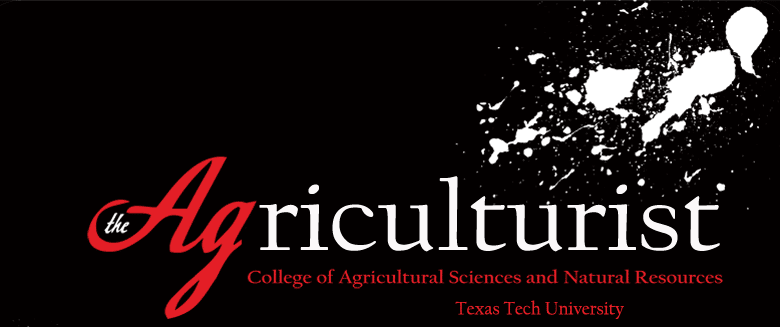
Table of Contents
Features
Agriculture: We Can Sustain It
Socializing Agriculture
Painter of Quiet Places
An Apple a Day
Sustaining the Four Sixes
Hitting Pay Dirt
The New Face of Agriculture
The Winds of Change
Avatars Animate Agriculture
Professors in Training
Going Green
Saving Lives One Plan at a Time
Protecting Our Food
Quality Cells, Consumer Buys
Tech's New Mate
Micro ZAP
Food Saftey in Mexico
Expanding Opportunities
No Bits About It
The Family Farm Fire Man
Around the World with CASNR
Live From Texas Tech
Looking Forward
Getting Schooled
A Cotton Senstaion
Living and Learning
More Than a Trophy
Online Exclusives
Alumni Lance Barnett: Unpeeled
Agricultural Education and CommunicationDepartment Shines in 2010
CSI: Classroom Soil Investigation
Facing Nature
GINuine
Healing Hooves
Parking and Partying in Style
Raider Red Meats
Standing TALL
Tech Takes Flight
West Texas Cotton Goes Global
Quality Cells, Consumer Buys
By Amber Krause
Beef has become a staple of American culture. Steakhouses are now the traditional go-to restaurant for a satisfying beef-eating experience. But on these restaurant menus, there seems to be a plethora of choices for each restaurant-goer.When it is time to order,the customers’ decisions can vary depending on personal preference. Although for some price may be the deciding factor, others choose based on taste. These decisions greatly impact the beef industry as it stuggles to meet consumer demands.
Researchers at Texas Tech University have discovered a method to increase these desired characteristics, while maintaining balance between taste and affordability.
The research is led by Gordon W. Davis Regent’s Chair in Meat & Muscle Biology Brad Johnson. The professor in the Animal and Food Science Department started his initial studies in muscle biology at Kansas State University with his colleague, Ki Yong Chung.
After more than 20 years of collaborative research on skeletal muscle development, Johnson and Chung found certain fat cells have different cell receptors. This finding was a segway into the current research that was initiated in 2006. It is directed toward feed additives and how the practices impact the end quality of an animal.
Johnson said the research has two goals - to meet the demand for high-quality beef and to increase the feed efficiency in beef cattle. He continues to explain that producers tend to over-feed cattle to gain a larger profit.
Producers are paid based on weight and quality. The fat content of the animal directly influences quality. Increasing the amount of feed will result in additional pounds and fat. Therefore, the producer’s profit is amplified.
But Johnson said he hopes to provide a more effective way to produce high-quality cattle and eliminate unnecessary feeding. To study possible solutions in the laboratory, the cellular structures of the longissimus dorsi are examined and tested through the use of different additives.
Prior to testing, the muscle and fat cells are separated. The fat cells can be further sorted into subcutaneous and intramuscular cells. Subcutaneous cells combine to create the outside fat covering of the muscle, while intramuscular cells are the flecs of fat in the muscle, also known as marbling.
At Kansas State, Johnson and Chung found intramuscular fat cells had a particular cell receptor not present in the subcutaneous fat cell. Chung, a doctorate research faculty member, said subcutaneous and intramuscular fat cells have different energy sources.
This information will help identify an additive to trigger the receptor on the intramuscular cell alone. If discovered, the particular additive will increase marbling, while not affecting the outside layer of fat. Consequently, this will produce a higher-quality product.
In alignment with the research regarding fat cells, other research in the Animal and Food Science Department is geared toward muscle cell growth and reducing the cost for high-quality products.
Rebecca Tokach, a master’s student who works for Johnson, studies Zilpaterol, an agent increasing red meat yield, while decreasing fat. She explains higher meat yields result in positive cost effects for producers and consumers.
“With the research I’m doing,” Tokach said, “we know that feeding Zilpaterol will add more pounds of product, which makes it more profitable for the producer and more affordable for the consumer.”
Tokach said originally, Zilpaterol was thought to decrease all fat cells. In reality, she explained the decrease in marbling was a dilution effect instead. There was less marbling because the ribeye was larger, not because of less intramuscular fat cells.
The hope of the present research, Tokach said, is to find an additive activating intramuscular cells and increasing marbling. Thus, it could be fed in conjunction with Zilpaterol to increase meat yields.
For producers, Johnson explained, the research will be helpful in efforts to add quality to cattle and will put more dollars in the cattle producers’ pocket.
“If we can use all these technologies available to increase muscle and then get a technology to increase marbling,” Johnson said, “in the end, we would decrease the number of days on feed and have a huge advantage from a feed efficiency standpoint.”
Johnson said Texas Tech will benefit through industry recognition, discovery funds and on-going research opportunities.
The research is beyond the Animal and Food Science Deartment, Johnson said. He explained the results of the research has attracted multiple companies. Leading industry and pharmacutical companies are interested in licensing the discovery of an additive increasing intramuscular fat cells.
Consumer preferences are still intact and actively affecting the production of the American beef supply. By utilizing genetic and cellular research, Texas Tech can essentially enhance the merit of beef across all segments of the industry. In the near future, though options will still be printed on the menu, the consumer will not have to place preference on the factors making a steak appetizing. The consumers desison will be effortless.